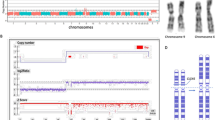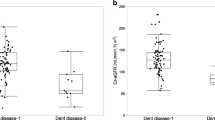Abstract
Background
Approximately 15% of patients with Dent disease have pathogenic variants in the OCRL gene on Xq25-26, a condition that is referred to as Dent disease 2 (Dent-2). Dent-2 patients sometimes show mild extrarenal features of Lowe syndrome, such as mild mental retardation, suggesting that Dent-2 represents a mild form of Lowe syndrome. To date, eight female patients with Lowe syndrome have been reported, but no female Dent-2 patients have been reported.
Methods
In this study, we performed genetic testing of the first female Dent-2 patient to detect the presence of an OCRL variant. Aberrant splicing was demonstrated by in vivo, in vitro, and in silico assays, and skewed X-chromosome inactivation (XCI) in our patient and asymptomatic mothers of three Lowe patients with the heterozygous OCRL variant was evaluated by HUMARA assays using genomic DNA and RNA expression analysis.
Results
Our patient had an OCRL heterozygous intronic variant of c.1603-3G > C in intron 15 that led to a 169-bp insertion in exon 16, yielding the truncating mutation r.1602_1603ins (169) (p.Val535Glyfs*6) in exon 16. HUMARA assays of leukocytes obtained from this patient demonstrated incompletely skewed XCI (not extremely skewed). On the other hand, the asymptomatic mothers of 3 Lowe patients demonstrated random XCI. These results may lead to our patient’s Dent-2 phenotype.
Conclusions
This is the first report of a female patient clinically and genetically diagnosed with Dent-2 caused by an OCRL heterozygous splicing site variant and skewed XCI. Skewed XCI may be one of the factors associated with phenotypic diversity in female patients with Lowe syndrome and Dent-2.




Similar content being viewed by others
References:
Lowe CU, Terrey M, Mac LE. Organic-aciduria, decreased renal ammonia production, hydrophthalmos, and mental retardation; a clinical entity. AMA Am J Dis Child. 1952;83(2):164–84. https://doi.org/10.1001/archpedi.1952.02040060030004.
Richards W, Donnell GN, Wilson WA, Stowens D, Perry T. The oculo-cerebro-renal syndrome of Lowe. Am J Dis Child. 1965;109:185–203. https://doi.org/10.1001/archpedi.1965.02090020187001.
Attree O, Olivos IM, Okabe I, Bailey LC, Nelson DL, Lewis RA, et al. The Lowe's oculocerebrorenal syndrome gene encodes a protein highly homologous to inositol polyphosphate-5-phosphatase. Nature. 1992;358(6383):239–42. https://doi.org/10.1038/358239a0.
Bokenkamp A, Ludwig M. The oculocerebrorenal syndrome of Lowe: an update. Pediatr Nephrol. 2016;31(12):2201–12. https://doi.org/10.1007/s00467-016-3343-3.
De Matteis MA, Staiano L, Emma F, Devuyst O. The 5-phosphatase OCRL in Lowe syndrome and Dent disease 2. Nat Rev Nephrol. 2017;13(8):455–70. https://doi.org/10.1038/nrneph.2017.83.
Claverie-Martin F, Ramos-Trujillo E, Garcia-Nieto V. Dent’s disease: clinical features and molecular basis. Pediatr Nephrol. 2011;26(5):693–704. https://doi.org/10.1007/s00467-010-1657-0.
Hoopes RR Jr, Shrimpton AE, Knohl SJ, Hueber P, Hoppe B, Matyus J, et al. Dent disease with mutations in OCRL1. Am J Hum Genet. 2005;76(2):260–7. https://doi.org/10.1086/427887.
Bockenhauer D, Bokenkamp A, Nuutinen M, Unwin R, Van't Hoff W, Sirimanna T, et al. Novel OCRL mutations in patients with Dent-2 disease. J Pediatr Genet. 2012;1(1):15–23. https://doi.org/10.3233/PGE-2012-005.
Bokenkamp A, Bockenhauer D, Cheong HI, Hoppe B, Tasic V, Unwin R, et al. Dent-2 disease: a mild variant of Lowe syndrome. J Pediatr. 2009;155(1):94–9. https://doi.org/10.1016/j.jpeds.2009.01.049.
Cau M, Addis M, Congiu R, Meloni C, Cao A, Santaniello S, et al. A locus for familial skewed X chromosome inactivation maps to chromosome Xq25 in a family with a female manifesting Lowe syndrome. J Hum Genet. 2006;51(11):1030–6. https://doi.org/10.1007/s10038-006-0049-6.
Scholten HG. A girl with Lowe’s syndrome. Maandschr Voor Kindergeneeskd. 1960;28:251–5.
Svorc J, Masopust J, Komarkova A, Macek M, Hyanek J. Oculocerebrorenal syndrome in a female child. Am J Dis Child. 1967;114(2):186–90.
Sagel I, Ores RO, Yuceoglu AM. Renal function and morphology in a girl with oculocerebrorenal syndrome. J Pediatr. 1970;77(1):124–7. https://doi.org/10.1016/s0022-3476(70)80056-7.
Hodgson SV, Heckmatt JZ, Hughes E, Crolla JA, Dubowitz V, Bobrow M. A balanced de novo X/autosome translocation in a girl with manifestations of Lowe syndrome. Am J Med Genet. 1986;23(3):837–47. https://doi.org/10.1002/ajmg.1320230311.
Cyvin KB, Weidemann J, Bathen J. Lowes syndrome. Acta Paediatr Scand. 1973;62(3):309–12. https://doi.org/10.1111/j.1651-2227.1973.tb08109.x.
Mueller OT, Hartsfield JK Jr, Gallardo LA, Essig YP, Miller KL, Papenhausen PR, et al. Lowe oculocerebrorenal syndrome in a female with a balanced X;20 translocation: mapping of the X chromosome breakpoint. Am J Hum Genet. 1991;49(4):804–10.
Minamikawa S, Nozu K, Nozu Y, Yamamura T, Taniguchi-Ikeda M, Nakanishi K, et al. Development of ultra-deep targeted RNA sequencing for analyzing X-chromosome inactivation in female Dent disease. J Hum Genet. 2018;63(5):589–95. https://doi.org/10.1038/s10038-018-0415-1.
Yokota K, Nozu K, Minamikawa S, Yamamura T, Nakanishi K, Kaneda H, et al. Female X-linked Alport syndrome with somatic mosaicism. Clin Exp Nephrol. 2017;21(5):877–83. https://doi.org/10.1007/s10157-016-1352-y.
Nozu K, Iijima K, Kawai K, Nozu Y, Nishida A, Takeshima Y, et al. In vivo and in vitro splicing assay of SLC12A1 in an antenatal salt-losing tubulopathy patient with an intronic mutation. Hum Genet. 2009;126(4):533–8. https://doi.org/10.1007/s00439-009-0697-7.
Inoue T, Nagano C, Matsuo M, Yamamura T, Sakakibara N, Horinouchi T, et al. Functional analysis of suspected splicing variants in CLCN5 gene in Dent disease 1. Clin Exp Nephrol. 2020. https://doi.org/10.1007/s10157-020-01876-x.
Hichri H, Rendu J, Monnier N, Coutton C, Dorseuil O, Poussou RV, et al. From Lowe syndrome to Dent disease: correlations between mutations of the OCRL1 gene and clinical and biochemical phenotypes. Hum Mutat. 2011;32(4):379–88. https://doi.org/10.1002/humu.21391.
Recker F, Reutter H, Ludwig M. Lowe syndrome/Dent-2 disease: a comprehensive review of known and novel aspects. J Pediatr Genet. 2013;2(2):53–68. https://doi.org/10.3233/PGE-13049.
Nakanishi K, Nozu K, Hiramoto R, Minamikawa S, Yamamura T, Fujimura J, et al. A comparison of splicing assays to detect an intronic variant of the OCRL gene in Lowe syndrome. Eur J Med Genet. 2017;60(12):631–4. https://doi.org/10.1016/j.ejmg.2017.08.001.
Acknowledgements
This study was supported by Grants-in-Aid for Scientific Research (KAKENHI) from the Ministry of Education, Culture, Sports, Science and Technology of Japan (subject ID: 19K17297 to Nana Sakakibara, 17H04189 to Kazumoto Iijima and 19K08726 to Kandai Nozu). The authors thank Ichiro Kobayashi and Yukiyo Ohshima (Department of Pediatrics, KKR Sapporo Medical Center, Sapporo, Japan) for providing us with medical information on the patient and her family. they also thank Tomohiko Yamamura and Tomoko Horinouchi (Department of Pediatrics, Kobe University Graduate School of Medicine, Kobe, Japan) for conducting the genetic examination. They thank American Journal Experts for editing a draft of this manuscript.
Author information
Authors and Affiliations
Corresponding author
Ethics declarations
Conflict of interest
The authors declare that they have no conflicts of interest to report.
Research involving human participants or animals
Our patient is a patient at Hokkaido University Hospital and this analysis was performed at Kobe University Graduate School of Medicine. All procedures performed in this study were reviewed and approved by the Institutional Review Board of Hokkaido University Hospital (IRB approval number 019–0412) and Kobe University Graduate School of Medicine (IRB approval number 019–301).
Informed assent and consent
Informed assent was obtained from the patient and informed consent was obtained from her parents.
Additional information
Publisher's Note
Springer Nature remains neutral with regard to jurisdictional claims in published maps and institutional affiliations.
Electronic supplementary material
Below is the link to the electronic supplementary material.
10157_2020_1926_MOESM1_ESM.pdf
Supplementary file1 (PDF 3385 kb) Figure 1. The de novo mutation in our patient is located on the paternal X chromosome a.In intron 17 of the OCRL gene, the mother had a benign variant (c.1879+38_1879+39insTCC, dBSNP:rs34007381), while the father did not have this benign variant. b.Genetic analysis of our patient demonstrated that this benign variant was not found in the allele with the de novo mutation in intron 15 that was separated by subcloning of the purified PCR products.
10157_2020_1926_MOESM2_ESM.pdf
Supplementary file2 (PDF 6300 kb) Figure 2. Relationship between the degree of skewedness of X-chromosome inactivation and clinical severity in female cases with heterozygous OCRL mutations a.Clinical and genetic characteristics of 3 Lowe patients whose mothers have heterozygous OCRL mutations. b.XCI analysis by HUMARA assay in peripheral leukocytes in the mothers of 3 Lowe patients with the heterozygous OCRL variant. All of them demonstrated no skewed XCI. c.Summary of XCI in female cases with heterozygous OCRL mutation.
About this article
Cite this article
Okamoto, T., Sakakibara, N., Nozu, K. et al. Onset mechanism of a female patient with Dent disease 2. Clin Exp Nephrol 24, 946–954 (2020). https://doi.org/10.1007/s10157-020-01926-4
Received:
Accepted:
Published:
Issue Date:
DOI: https://doi.org/10.1007/s10157-020-01926-4




